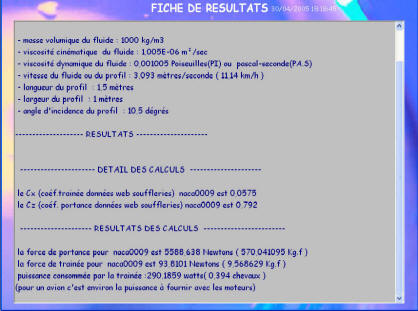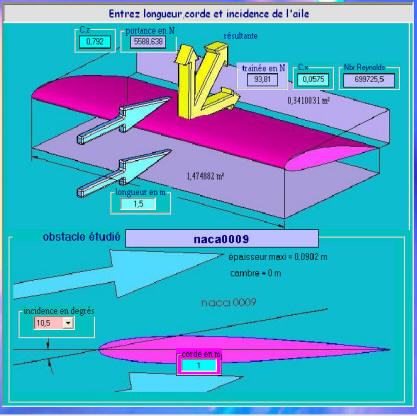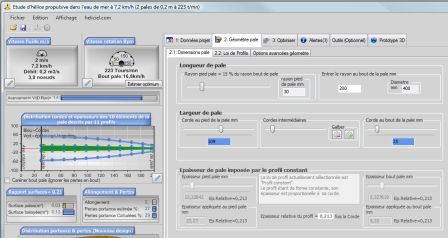Example of calculating a boat keel dagger board rudder profile, with software mecaflux:
What are the forces?
The wind in the sails (sail example calculation), generates a propulsive component (this is the one that moves the boat) and a drift component. (This is the one that push the boat on the side). We will assume for this calculation that the drift component is 1000 Newtons and applies a profile that we call: dagger board .
The role of this dagger board is to create a force drift control balancing 1000N with the Lift force generated by its profile.
Fluid velocity is the speed of the boat.
The incidence (or attack) of profile, relative to the direction of the fluid, is the slip angle of the boat or drift. You have, in the converter mecaflux, a trigonometric triangle, which will give you the angle of incidence quickly if you enter the distance as adjacent side and drift as opposite side.
In reality, the lift is perpendicular to the movement of fluid but slightly simplify our example.
-We seek a lift force that balances 1000 Newtons
To realize this we can playing on:
-boat speed (average speed for a boat: 6 knots) (use convertor)
-the slip angle of the boat (that is the angle formed by the axis of the vessel with its actual trajectory)
-the length of the dagger board
-the width or chord of the dagger board:
calculating dagger board with mecaflux software
- Select a profile with drag and lift for your dagger board, if it is a drift windsurfing or boat he'd better be symmetrical (when you enter the profile chord its camber appears, if it remains null, is that it is a symmetrical profile).
Two symmetrical profiles tested in the wind tunnel are usable: NACA0009 and J5012 (polar patterns are already set in MECAFLUX but you can change the Cd and CL , Here we chose NACA0009 .
- Enter the parameters of the fluid (speed : 6 knotes, temperature:20°C, density:1000Kg/m3)
- Enter the profile chord (the width of the dagger board, take 1 meter)
- Enter the length of the dagger board (say 1.5 meters)
- Enter incidence profile (attack angle betwen the flow direction and the profile chord) let's try 10.5°. The proposed impact values are those studied in wind tunnels, they are limited to the interesting angles, beyond the profiles are stalling)
-Click to calculate

The result sheet is convenient to print or save the calculations, but for our case rather look at the diagram, close the result sheet:

The diagram of the profile indicates the value of the lift and drag ...
We see that the lift is 5588 Newtons ( 570 Kg.f ) this is far more than we need, we can say that our daggerboard, when the boat drifting 10.5°,more than makes up slippage. We can assume, at this speed (6 knots) it will never reach this drift angle.. Then adjust the angle of drift until it generates a lift balancing 1000 Newtons...
-With 3° incidence :Lift=1748 Newtons ( 178 Kg.f ) Drag: 5,1 Newtons
-With 1.5° incidence : Lift=911 Newtons ( 92 Kg.f ) Drag:4,4 Newtons
We can say that our greaSupert-Daggerboard give us a super-boat that derive only 1.5° à 2°. Which will be the envy of América-cup competitors. Unfortunately the drag of our super-Profile is a super drag and super-slowing down our boat (it will take about 1m ² of additional sail at force 5 to compensate for its drag ......)

Seek a lower drag by reducing the friction surface of the profile::
- With an incidence 6° , a chord 0.5 and a length 1 meter (surface: 0.5m²) wee obtain:
Lift force of naca0009 is 104 Newtons ( 106,5 Kg.f )
Drag force for naca0009 is 4,2 Newtons
it is up to you to look for the best compromise between speed, incidence, drag, lift, size, strength ... of your future boat ...
MECAFLUX gives the results of a sufficient finesse to think and approach a good compromise , to refine the calculations of wings or daggerboards of more complex shapes by integrating losses tips, you can also use Heliciel .. See calculation daggerboards and wings with Heliciel:
Back to External flow exemples

